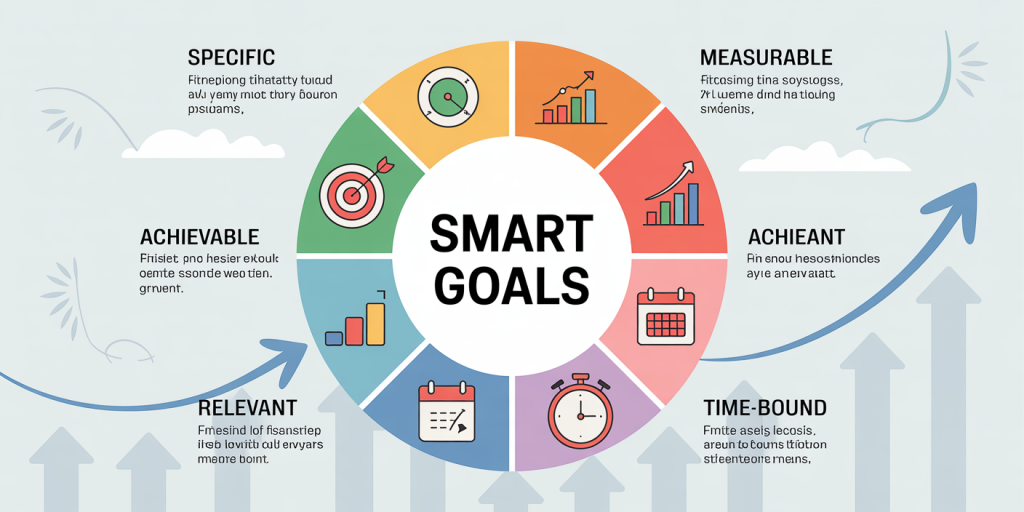How to Set Financial Goals You’ll Actually Stick To
Anúncios
Setting financial goals is a cornerstone of personal financial management, yet many individuals struggle to create goals they can realistically achieve and maintain. According to a 2023 study by the National Endowment for Financial Education, only 30% of Americans have a concrete financial plan, and fewer stick to their plans long term. With so many distractions and unpredictable expenses, creating financial goals that resonate personally and encourage persistent effort can seem daunting. However, mastering the art of setting practical, measurable, and motivating financial goals is crucial for maintaining financial stability and growing wealth over time.
This article provides a comprehensive guide to establishing financial goals that are actionable and sustainable. By understanding the psychological drivers behind goal-setting, employing proven techniques, and learning from real-life success stories, you can set yourself up for lasting financial success.
Anúncios
—
The Psychology of Financial Goal-Setting: Why Many Fail
Many people fail to achieve their financial goals because they set goals that are either too vague or unrealistically ambitious. Psychologists highlight the difference between goal intentions and goal commitments: while intentions reflect what a person hopes to do, commitment is an active, binding decision that drives persistent behavior.
An example is someone who says, “I want to save money,” without specifying how much or by when. This fuzzy objective lacks the clarity needed to motivate day-to-day discipline. Research by Dr. Gail Matthews at Dominican University found that individuals who wrote down their goals, shared them with a friend, and regularly reviewed progress were 42% more likely to accomplish those goals.
Financial stress also plays a role. The American Psychological Association reports that 64% of adults experience financial stress that impacts decision-making and goal adherence. In times of stress, people may revert to impulsive spending rather than sticking to their budget.
Understanding these psychological factors helps in framing your finances in a goals-oriented, manageable way. By crafting goals with specific parameters and establishing accountability, you combat common pitfalls like procrastination and loss of motivation.
—
Crafting SMART Financial Goals: The Roadmap to Success
Setting financial goals using the SMART criteria—Specific, Measurable, Achievable, Relevant, and Time-bound—has been a standard because it balances ambition with practicality. Let’s break down each element with actionable examples: Specific: Instead of “Save money,” aim for “Save $5,000 for an emergency fund.” This gives a target. Measurable: You can track progress monthly, such as depositing $416 into a savings account. Achievable: Consider current income and expenses to ensure $416/month is realistic. Relevant: An emergency fund supports financial security, aligning with broader personal values. Time-bound: Set a 12-month deadline to create urgency and focus.


Example of SMART Goal vs Non-SMART Goal:
| Aspect | Non-SMART Goal | SMART Goal |
|---|---|---|
| Specific | Save money | Save $5,000 for emergency fund |
| Measurable | No measurable target | Deposit $416 each month |
| Achievable | Overambitious | Realistic based on income and expenses |
| Relevant | Vague | Supports financial security |
| Time-bound | No deadline | Complete within 12 months |
By constructing goals using SMART guidelines, individuals can create clear benchmarks and assess their progress objectively.
—
Prioritizing Goals For Impact: Short-Term vs Long-Term Planning
Not all financial goals are created equal. Understanding the distinction between short-term and long-term goals allows for better allocation of resources and sustained motivation.
Short-Term Goals
Short-term financial goals typically span from a few weeks up to a year. These can include: Paying off a credit card balance of $1,200 within 6 months. Saving $1,000 for an upcoming vacation. Building a $500 emergency buffer.

These goals serve as achievable wins, which help build confidence and momentum. For instance, Sarah, a 28-year-old marketing professional, focused on clearing a $2,000 credit card debt over 8 months by setting a budget that cut discretionary spending by 20%. Her quick success reduced her financial stress and motivated her to tackle longer-term goals.
Long-Term Goals
Long-term goals often extend over several years or decades: Accumulating $500,000 for retirement savings by age 65. Paying off a mortgage within 20 years. Saving for a child’s college education.
Because results aren’t immediate, these goals require consistent habits and regular tracking. Tools like 401(k) contributors, IRAs, and educational savings accounts facilitate progress towards these benchmarks.
Table: Examples of Financial Goals by Time Horizon
| Time Horizon | Goal Example | Typical Timeframe | Primary Benefit |
|---|---|---|---|
| Short-term | Clear $1,000 credit card debt | 3-12 months | Immediate financial relief |
| Medium-term | Save $10,000 for a home down payment | 1-5 years | Enables major life purchases |
| Long-term | Grow retirement fund to $500,000 | 10-40 years | Long-term financial security |
Allocating resources effectively often means balancing these goal types according to your life stage and financial situation. Younger individuals may prioritize short and medium-term goals, while those approaching retirement focus on long-term financial security.
—
Leveraging Budgeting and Automation for Goal Adherence
Even the most well-crafted financial goals can fail without consistent action. Budgeting and automation are practical tools that help maintain progress by minimizing the need for ongoing willpower.
A 2022 study by the U.S. Federal Reserve shows that 54% of adults use some form of budgeting app or method to manage finances, and those who budget are 81% more likely to meet savings goals.
The Role of Budgeting
Budgeting provides clear visibility on income, expenses, and cash flow. The 50/30/20 rule is a popular framework that divides after-tax income into essentials (50%), wants (30%), and savings or debt repayment (20%). For instance, if your monthly income is $4,000, this model recommends allocating $800 to savings monthly.
Budgeting apps like YNAB (You Need A Budget), Mint, or everydollar allow you to categorize spending, set spending limits, and track progress towards individual goals seamlessly.
Automation for Consistency
Proactively automating savings and bill payments removes the human element that often leads to missed contributions or impulsive spending. Automatic transfers to high-yield savings accounts or retirement plans safeguard goal progress, especially important in times of market volatility or personal financial strain.
Real-world case: John, a 35-year-old software engineer, automated $500/month transfers to his brokerage account. Over five years, this discipline resulted in a portfolio growth exceeding $35,000, demonstrating the power of consistent, automated investments.
—
The Importance of Accountability and Regular Review
Sticking to financial goals is easier when you have someone or something to hold you accountable. Sharing goals publicly or with trusted friends increases commitment. Dr. Matthews’ research into goal achievement showed that people who shared progress with a confidant had significantly higher success rates.
Accountability Partners and Support Networks
Joining financial support groups or working with a financial advisor creates structured accountability. Monthly check-ins help identify challenges, adjust tactics, and celebrate wins.
Consistent Monitoring and Adjustment
Life events, such as job changes or unforeseen emergencies, may require recalibration of goals. Regular review sessions — quarterly or biannually — allow you to assess progress and make necessary adjustments. For example, if your income increases, you can accelerate savings rates. Conversely, during lean periods, extending timelines may be necessary to maintain momentum without burnout.
—
Future Perspectives: Adapting Financial Goals in a Changing Economic Environment
The global economic landscape influences the feasibility of financial goals. Rising inflation, fluctuating interest rates, and evolving labor markets require adaptable financial planning frameworks. For instance, the U.S. inflation rate averaged 6.5% in 2023, affecting purchasing power and savings plans.
Flexibility Is Key
As economic conditions change, so too should your financial goals. Building flexibility into your plans—such as setting tiered targets or contingency buffers—enhances resilience. For example, instead of targeting $10,000 in savings, a tiered goal might be $7,000 as a minimum and $10,000 as an ideal.
Digital innovations, including AI-powered budgeting tools, robo-advisors, and blockchain financial products, promise more personalized and efficient financial management. Staying informed about such technologies allows you to optimize goal achievement strategies.
The Role of Financial Education
Increasingly, financial literacy has emerged as a critical factor in successful goal adherence. According to a 2023 FINRA survey, adults with high financial literacy are 2.5 times more likely to plan for retirement and maintain emergency savings. Continuous learning about budgeting strategies, investment options, and changing market trends ensures your goals stay relevant and achievable.
—
By integrating psychological insights, employing SMART criteria, balancing short- and long-term goals, utilizing budgeting and automation, enlisting accountability, and adapting to evolving economic realities, you’re better equipped to set financial goals that you’ll actually stick to. These strategies not only improve your financial outcomes but also foster confidence and control over your financial future.
